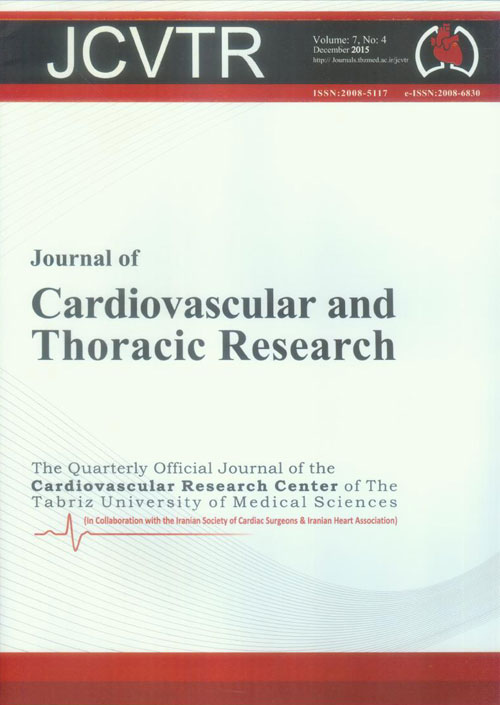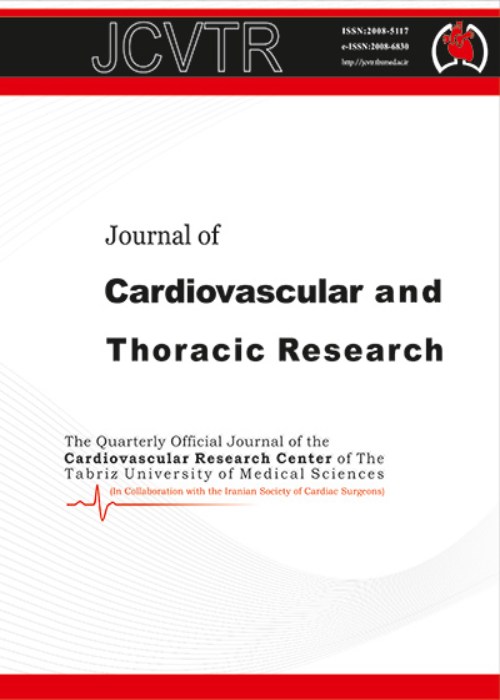فهرست مطالب

Journal of Cardiovascular and Thoracic Research
Volume:7 Issue: 4, Dec 2015
- تاریخ انتشار: 1394/10/10
- تعداد عناوین: 10
-
-
Pages 134-140IntroductionThe aim of this study was to measure the haemodynamic responses to a etomidate-propofol combination used for anaesthesia induction and to compare the haemodynamic responses with the separate use of each drug.MethodsThe patients were randomly divided into three groups as group P (n = 30, propofol 2.5 mg kg-1), group E (n = 30, etomidate 0.3 mg kg-1) and group PE (n = 30, propofol 1.25 mg kg-1 + etomidate 0.15 mg kg-1). For each patient, the times of measurement of the heart rate (HR) and mean arterial pressure values were defined as baseline, after the induction, before the intubation, immediately after the intubation and 1, 2, 3, 4, 5 and 10 minutes after the intubation.ResultsIn all 3 groups, a significant decrease in MAP values were seen at T2 and T3 compared to the baseline values, and this decrease was greater in group P compared to that in group E and PE (P < 0.001, P < 0.01). A significant increase was seen in all 3 groups in the mean arterial pressure (MAP) value at T4 after the intubation. When the groups were compared with each other, this increase was greater in group E than in the other two groups (with group P, P < 0.001; with group PE, P < 0.01).ConclusionEtomidate-propofol combination may be a valuable alternative when extremes of hypotensive and hypertensive responses due to propofol and etomidate are best to be avoided.Keywords: Etomidate_propofol combination may be a valuable alternative when extremes of hypotensive_hypertensive responses due to propofol_etomidate are best to be avoided
-
Pages 141-148IntroductionPostoperative pain-management with non-steroid anti-inflammatory drugs has been controversial, due to related side-effects. We investigated whether there was a significant difference between an oxycodone-based pain-management regimen versus a slow-release ibuprofen based regimen, in a short term post-cardiac surgery setting. Particular attention was given to the rate of myocardial infarction, sternal healing, gastro-intestinal complications, renal failure and all-cause mortality.MethodsThis was a single-centre, open label parallel design randomised controlled study. Patients, who were undergoing cardiac surgery for the first time, were randomly allocated either to a regimen of slow-release oxycodone (10 mg twice daily) or slow-release ibuprofen (800 mg twice daily) combined with lansoprazole. Data relating to blood-tests, angiographies, surgical details and administered medicine were obtained from patient records. The follow-up period was 1 to 37 months (median 25 months).ResultsOne hundred eighty-two patients were included in the trial and available for intention to treat analysis. There were no significant difference between the groups (P>0.05) in the rates of sternal healing, postoperative myocardial infarction or gastrointestinal bleeding. The preoperative levels of creatinine were found to increase by 100% in nine patients (9.6%) in the ibuprofen group, resulting in an acute renal injury (in accordance with the RIFLE-criteria). Eight of these patients returned to normal renal function within 14 days. The levels of creatinine in patients in the oxycodone group were not found to increase to the same magnitude.ConclusionThe results of this study suggest that patients treated postoperatively, following cardiac surgery, are at no greater risk of harm if short term slow release ibuprofen combined with lansoprazole treatment is used when compared to an oxycodone based regimen. Renal function should, however, be closely monitored and in the event of any decrease in renal function ibuprofen must be discontinued.Keywords: Cardiac surgery, Non, steroidal Anti, inflamatory Drugs, Acute Renal Injury, Analgesia
-
Pages 149-153IntroductionThe previous studies have suggested that alteration in oxidative stress and antioxidant defense depends on various factors, such as mode, intensity, frequency and duration of exercise. In this study, we compared the effects of two various durations of resistance exercise (1 month and 4 month) on oxidative stress and antioxidant status in cardiac tissue.MethodsThirty Wistar male rats divided into 3 groups: control (sedentary), exercise-1 (regular exercise for 1 month) and exercise-2 group (regular exercise for 4 months). After the final to the experiment, the rats were anesthetized, and then blood and heart samples were obtained and used to determine glutathione peroxidase (GPX), superoxide dismutase (SOD), malondialdehyde (MDA) and biochemical estimation.ResultsMDA levels between control and exercise-2 groups showed no significant difference, hence, MDA level in exercise-1 group was higher compared to control group (P <. 01). The heart GPX activity increased significantly in exercise-2 group regarding other groups (P <. 01). The SOD activities of groups were similar. Creatine kinase (CK) and lactate dehydrogenase (LDH) concentrations increased in the exercise-1 compared to the other groups (P <. 01).ConclusionOur results indicate that in heart, the adaptation and alteration in oxidative stress and cell injury level depend on duration of exercise.Keywords: Resistance Exercise, Oxidative Stress, Exercise Tolerance, Rat
-
Pages 154-157IntroductionP wave axis is one of the most practical clinical tool for evaluation of cardiovascular disease. The aim of our study was to evaluate the P wave axis in electrocardiogram (ECG), left atrial function and association between the disease activity score in patients with systemic lupus erythematosus (SLE).MethodsStandard 12-lead surface ECGs were recorded by at a paper speed of 25 m/s and an amplifier gain of 10 mm/mV. The heart rate (HR), the duration of PR, QRS, QTd (dispersion), the axis of P wave were measured by ECG machine automatically.ResultsThe P wave axis was significantly increased in patients with SLE (49 ± 20 vs. 40 ± 18, P = 0.037) and the disease activity score was found positively correlated with P wave axis (r: 0.382, P = 0.011). The LA volume and the peak systolic strain of the left atrium (LA) were statistically different between the groups (P = 0.024 and P = 0.000). The parameters of the diastolic function; E/A and E/e’ were better in the control group than the patients with SLE (1.1 ± 0.3 vs. 1.3 ± 0.3, P = 0.041 and 6.6 ± 2.8 vs. 5.4 ± 1.4, P = 0.036, respectively).ConclusionP wave axis was found significantly increased in patients with SLE and positively correlated with SELENA-SLEDAI score. As the risk score increases in patients with SLE, P wave axis changes which may predict the risk of all-cause and cardiovascular mortality.Keywords: P Wave Axis, Systemic Lupus Erythematosus, Left Atrial Volume, Left Atrial Strain
-
Pages 158-163IntroductionMetabolic Syndrome (MS) in children and adolescents is becoming a global public health concern. MS tracks into adulthood increasing the risk for type 2 diabetes mellitus and cardiovascular diseases. This study was designed to verify the rate of MS in elementary school students of Birjand, as a representative sample of Iranian children to verify the best preventive measures in this age group.MethodsThis descriptive-analytical, cross-sectional study was performed on 1425 elementary school children through multiple-cluster sampling in 2013. Height, weight, waist circumference and blood pressure of children were measured by standard methods. Blood glucose, triglycerides, cholesterol, High-density lipoprotein-cholesterol (HDL-C) and low-density lipoprotein-cholesterol (LDL-C) levels were also measured after 12 hours fasting. MS was defined according to the Adult Treatment Panel III (ATP-III) based on the National Cholesterol Education Program. Data were analyzed by SPSS using t test and chi-square test. Significance level was set at P < 0.05.ResultsThe prevalence of MS was 5.3% which increased with age. 43.5% of the studied cases had one or more components of the MS. The most common components were hypertension, abdominal obesity, hypertriglyceridemia, low HDL-cholesterol and impaired fasting glucose, respectively. MS prevalence was 0.9% in normal weight, 11.3% in overweight and 36.2% in obese children.ConclusionRegarding the high prevalence of MS in elementary school children in our region, screening for obesity is recommended to prevent adulthood complications. Therapeutic lifestyle changes and maintenance of regular physical activity are the most important strategies for preventing childhood obesity.Keywords: Metabolic Syndrome, Childhood Obesity, Elementary School Children
-
Pages 164-167IntroductionIschemic heart diseases (IHDs) are the leading cause of mortality worldwide. However the global burden of IHD has been concentrated on developing countries, where limited research efforts have been made to address these needs. This study aimed to understand the global distribution of IHD research activities by looking at the countries’ burden of disease, income and development data.MethodsAs a scientometric study, Scopus database was searched for research publications indexed under the medical subject heading (MeSH) ‘myocardial ischemia’ including the following terms: coronary artery disease, coronary heart disease, and ischemic heart disease. The number of research publications in Scopus database was recorded for each individual year 2000-2012, and for each country. Data for estimated IHD disability-adjusted life-year’s (DALY’s), gross domestic product (GDP) per capita and human development index were also included for the analysis.ResultsIHD research publications were most likely produced by European and Western pacific countries. High-income countries produced the greatest share of about 81% of the global IHD research. However, no significant association observed between the countries’ GDP and number of research publications worldwide (OR = 0.98, P = 0.939). Global IHD research found to be strongly associated with the burden of disease (P < 0.0001) and the countries’ HDI values worldwide (OR = 16.8, P = 0.016).ConclusionOur study suggested that global research on IHD were geographically distributed and highly concentrated among the world’s richest countries. Estimated DALYs and HDI were found as important predictors of IHD research and the key drivers of health research disparities across the world.Keywords: Ischemic Heart Disease, National Income, Mortality, Burden of Disease
-
Pages 168-171IntroductionThere is a dearth of literature on tetralogy of fallot (TOF) in children in Sub-Saharan Africa. This study up aims to describe the prevalence, clinical profile and associated cardiac anomaly of children diagnosed with TOF documented over an eight year period in a tertiary hospital in South Western Nigeria.MethodsA prospective review of all consecutive cases of TOF diagnosed with echocardiography at the Lagos State University Teaching Hospital (LASUTH) between January 2007 and December 2014. Data were analyzed using SPSS version 20. Tables and charts were used to depict those variables. Descriptive statistic are presented as percentages or means and standard deviation. Means of normally distributed variables were compared using the student t-test and proportions using chi-square test. Skewed distribution were analyzed using appropriate non-parametric tests. Level of significance set at P < 0.05.ResultThe prevalence of TOF among children presenting at LASUTH at the study period was 4.9 per 10 000 while its prevalence among those with congenital heart disease was 16.9%. There was a male predominance and most children presented within 1-5 years of age. Chromosomal abnormalities such as Down syndrome, Turners syndrome and CATCH 22 syndrome were documented in some subjects. Some of the subjects had atypical presentation.ConclusionTOF is as common in Nigeria as other parts of the world, there is a need to established cardiac centers to salvage these children. Collaboration from developed countries will be helpful in this resource limited region.Keywords: Tetralogy, Fallot, Profile, Nigeria, Africa
-
Pages 172-174Herein, we are presenting a case of persistent interatrial septal defect diagnosed during coronary artery bypass grafting (CABG). Twice, attempts had been made to close this shunt using amplatzer septal occlude. However, percutaneous technique had failed in both occasions. The patient presented with chest pain 4 years after the second attempt and required urgent CABG. Persistent shunt was repaired during surgery.Keywords: Atrial Septal Defect, Amplatzer, Percutaneous Occluders
-
Pages 175-177Endovascular aneurysm repair (EVAR) is an adequate means for treating infrarenal abdominal aortic aneurysms (AAA). However, secondary interventions are required in approximately 15% to 20% of patients. The aim of this paper was to report our knowledge with stent grafts in secondary interventions after EVAR in a 73-year-old patient. One of the exceptional complications of EVAR are endoleaks which may lead to expansion of aneurysm and rupture if not repaired.Keywords: Endovascular Aneurysm, EVAR, Abdominal Aorta, Aneurysm


